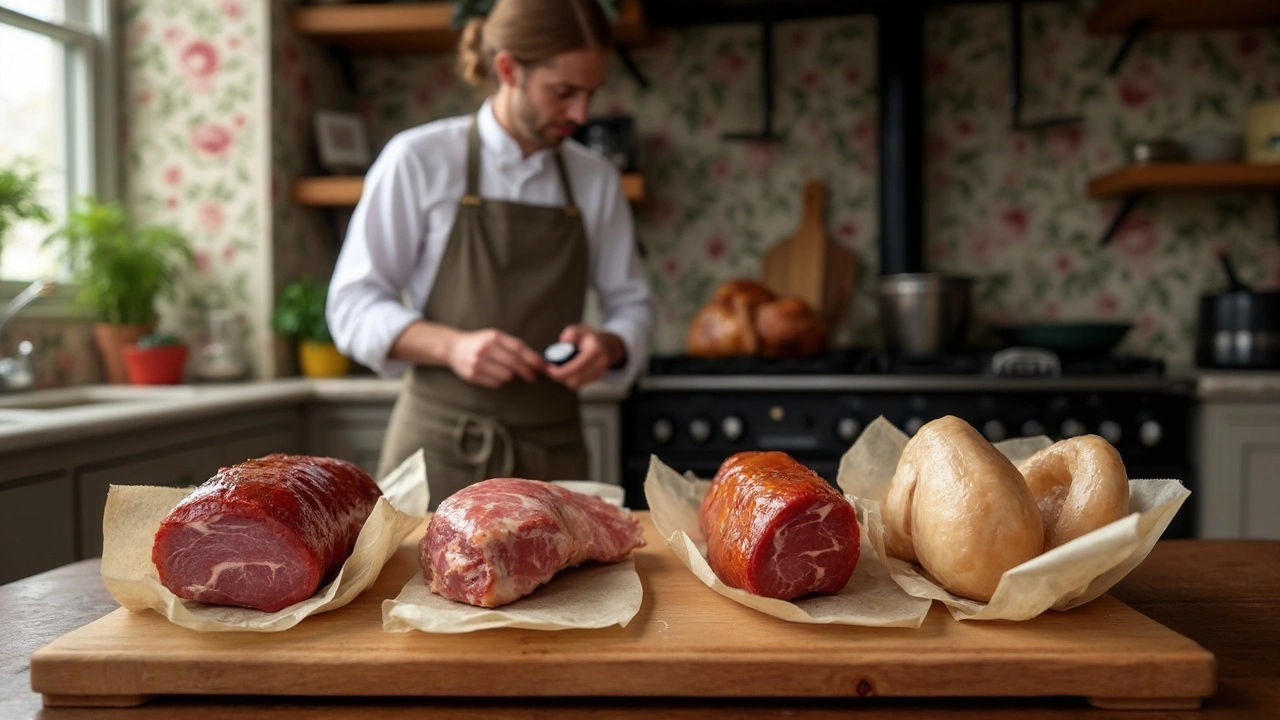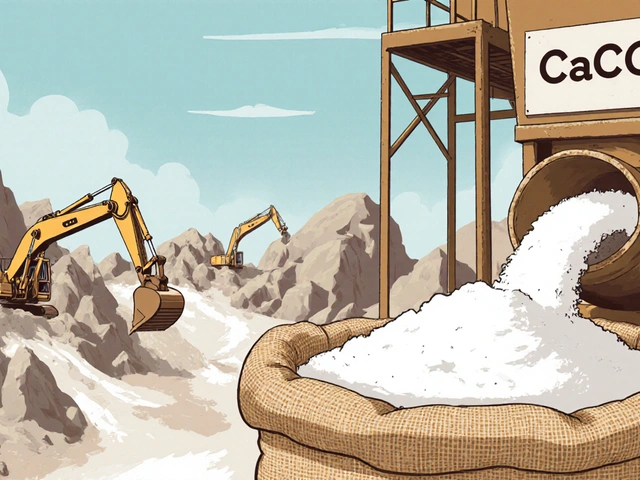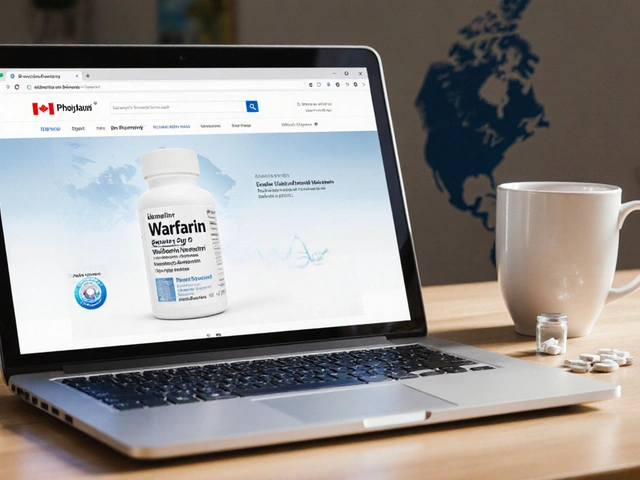Salmonellosis might not be the most glamorous topic, but it's something every home cook should take seriously. Why? Because salmonella, the pesky bacteria behind this illness, loves to lurk around your kitchen, just waiting for a chance to pounce on your prepped meals. It's not just raw chicken we need to worry about—think eggs, fruits, and even some veggies.
One of the easiest ways to keep salmonella out of your dinner plans is by staying clean. It sounds simple, but washing your hands, utensils, and countertops regularly makes a huge difference. Lather up those hands for at least 20 seconds, rinse well, and dry on a clean towel. And about those sponges and dishcloths? Change them often; they're like bacteria havens if you're not careful.
Next up, let’s talk about proper food handling. You know how sometimes it's tempting to use the same cutting board for everything? Try not to. Designate one for raw meats and another for your fruits and veggies. This way, you keep cross-contamination to a minimum.
- Understanding Salmonellosis
- The Importance of Cleanliness
- Safe Food Handling Techniques
- Cooking Temperatures and Food Storage
- Quick Tips for Kitchen Safety
Understanding Salmonellosis
Alright, let's dive into what salmonellosis actually is. At its core, it’s a bacterial infection caused by a group of bacteria known as Salmonella. These little guys are pretty common, especially in food and water, and they can wreak havoc on our stomachs if they find a way in.
So how does salmonella make its way into your kitchen? Well, it often hitches a ride on raw poultry, eggs, beef, and sometimes even unwashed fruits and veggies. It's sneaky because it doesn't really change the look or smell of the food.
Symptoms to Watch Out For
Getting sick with salmonellosis isn't a walk in the park. Symptoms usually include diarrhea, fever, and stomach cramps, starting around 12 to 72 hours after the bacteria gets into your system. For most folks, this isn't something that requires a hospital visit. The symptoms can last 4 to 7 days and you generally recover on your own, but it's not fun.
However, some people, like younger kids, older adults, and those with weakened immune systems, might have a harder time and could need more help to get better. So, taking preventive steps in your kitchen is really the best move.
Interesting Facts
| Fact | Detail |
|---|---|
| Incidence | Each year, about 1.35 million cases of salmonellosis are reported in the United States alone. |
| Duration | Symptoms can last between 4 to 7 days. |
Understanding the ins and outs of how salmonella operates is your first step in crafting a strategy to prevent it. Armed with this knowledge, you’ll be better prepared to make smart choices with food prep and storage. Next, let’s move on to cleanliness, which is your best friend in this battle against bacteria.
The Importance of Cleanliness
Keeping a spick-and-span kitchen isn't just about making things look good. It's a frontline defense against salmonellosis, helping you dodge this nasty bacterial infection. Have you ever thought about how quickly germs can spread from one surface to another? It's surprisingly fast! Studies have shown that bacteria can transfer from a dirty surface to hands and food in seconds.
Lead with Hand Hygiene
The most basic, yet most often neglected cleanliness tactic? Washing your hands. It sounds like a no-brainer, but it's super effective at keeping salmonella at bay. Make sure you're scrubbing for at least 20 seconds with soap and water, scrubbing those fingers and under nails thoroughly.
Keeping Surfaces Spotless
Good old elbow grease comes in handy. Regularly cleaning countertops, cutting boards, and utensils with hot, soapy water is crucial. Got a stubborn stain or spill? Consider using a mixture of vinegar and water as a natural disinfectant. It's surprising how powerful simplicity can be!
Be Cautious with Cloths
That innocent-looking dishcloth? It could be a party hotspot for germs. Change dishcloths and sponges frequently, ideally every other day, and always allow them to dry completely between uses. And if you're using any kind of cloth to wipe meat juices, toss it in the wash immediately afterward.
Utensil and Equipment Care
It's not just about washing them after use. Utensils and kitchen gadgets like blenders or food processors should be pulled apart and cleaned meticulously, making sure no food bits are left to harbor bacteria.
Here's a quick tip: if you want an effective and eco-friendly way to sanitize your kitchen tools, try popping them in a pot of boiling water for a few minutes. It's simple but works wonders.
By incorporating these cleanliness habits into your kitchen routine, you significantly cut down the risk of salmonellosis. A small effort every day can mean a big payoff in terms of health and safety at home.

Safe Food Handling Techniques
Handling food safely is more than just common sense—it's crucial for keeping salmonella out of your meals. Let's break down some essential techniques to help you maintain a kitchen where salmonella doesn't stand a chance.
Separate, Don't Cross-contaminate
One of the first rules is to keep raw meats away from other foods. No mixing raw chicken with veggies and certainly no tossing raw eggs around willy-nilly.
- Use different cutting boards: One for raw meat, another for fruits and vegetables.
- Store raw meat on the bottom shelf of the fridge to avoid drips on other foods.
- If you're prepping fruits and meats back to back, wash that board with hot, soapy water.
Temperature Is Key
Cooking food to the right temperature is a must to kill salmonella. You don't need to be a gourmet chef—just a reliable meat thermometer will do the trick.
- Chicken and turkey: Should hit an internal temp of 165°F (74°C).
- Beef and pork: A solid 145°F (63°C) is your target.
- Leftovers: Reheat to at least 165°F (74°C) for safety.
Tidy Up ASAP
It's not just about the prep; cleaning as you go is a lifesaver too.
- Wash your hands with soap before and after handling food—especially raw meat.
- Change dish towels and sponges regularly. They can harbor bacteria like it's their full-time job.
- Mop up spills promptly to avoid breeding grounds for bacteria.
If you're curious about what foods are most likely to carry salmonella, check out this handy table:
| Food | Risk Level |
|---|---|
| Poultry | High |
| Eggs | High |
| Fruits and Vegetables | Moderate |
| Dairy Products | Moderate |
By following these safe food handling tips, you'll be taking important steps to keep salmonellosis out of your home and your family healthy.
Cooking Temperatures and Food Storage
Alright, let's chat about one of the most important things—getting your cooking temperatures right. Trust me, this step is a game-changer when it comes to avoiding salmonella. So, for that juicy chicken breast or other poultry, make sure it hits at least 165°F (74°C) inside. If you're dealing with ground meats, aim for 160°F (71°C). And bonus tip? Invest in a good food thermometer. It can be a total lifesaver in the kitchen.
But it doesn't stop with just cooking the food. Proper storage is crucial to keep

Quick Tips for Kitchen Safety
Keeping your kitchen a safe haven from salmonellosis doesn't have to be daunting. In fact, it's all about developing a few simple habits that make a big difference.
Stay Clean, Stay Safe
The key to preventing salmonella is cleanliness. Always wash your hands thoroughly before and after handling raw foods, particularly meat and eggs. Dry them with a clean towel, or better yet, a disposable paper towel.
Smart Food Storage
How you store your food matters. Raw meat should be kept on the lowest shelf in the fridge to prevent juices from dripping onto other foods. Use airtight containers for leftovers and ensure your fridge is set at 40°F (about 4°C) or lower. This temperature slows bacterial growth significantly.
Temperature Check
Using a food thermometer is an easy way to ensure your food is cooked through. Poultry should reach at least 165°F (74°C), while ground meats need to hit 160°F (71°C) to be safe. Don’t rely on color alone; sometimes food can be cooked on the outside but not on the inside.
Quick Clean-Up
Spills and crumbs are best cleaned up immediately. Not only does this prevent accidents but it stops bacteria from multiplying. Disinfect surfaces regularly, especially after preparing food.
- Salmonella can survive on surfaces for days, so routine cleaning is essential.
- When marinating, do so in the fridge, and remember to discard the marinade before cooking.
Keep Pets Out
Our furry friends, as much as we love them, don’t always belong in the kitchen during meal prep. Pet paws and fur can easily carry germs to your prep area. Save the cuddles for later!
Remember, a few simple steps can save you and your family from a nasty bout of salmonellosis—and it’s well worth the effort!







AnneMarie Carroll
22 March 2025 - 16:02 PM
Ugh, I can't believe people still don't get that raw chicken is a biohazard. I had salmonella in 2018 and it nearly killed me. You think washing hands is enough? Nah. You need to sanitize EVERYTHING after touching meat. Even the fridge handles. I use bleach wipes now. No excuses.
John K
24 March 2025 - 12:44 PM
USA has the cleanest kitchens in the world. If you get sick from food, you probably didn't wash your hands or you're from a third world country. Also 🍗🔥
Laura Anderson
26 March 2025 - 07:22 AM
There's a metaphysical dimension to food safety that most people ignore. Salmonella isn't just bacteria-it's a manifestation of modern disconnection from ancestral wisdom. We've replaced ritual with efficiency, and now we pay the karmic price. Your cutting board? It's not just wood. It's a mirror of your soul's cleanliness.
When you touch raw chicken, you're not just handling protein-you're confronting the shadow self. The bacteria? It's the unprocessed trauma of industrial agriculture. Clean hands? That's just the surface. You need to cleanse your intentions too.
I once meditated with a raw egg in my palm for 20 minutes. I felt its vibration. It whispered, 'You're not ready.' I cried. Then I washed my hands. With intention.
Stop treating this like a hygiene checklist. This is spiritual hygiene. The FDA doesn't teach you this. But I do.
Avis Gilmer-McAlexander
26 March 2025 - 09:07 AM
Okay but can we talk about how wild it is that we’re so scared of bacteria but we put glitter and glitter glue on our kids’ faces? Like, one’s a microscopic nightmare, the other’s just… sparkles? 🌈
I started using color-coded cutting boards-red for meat, green for veggies, blue for fish-and now my kitchen looks like a rainbow exploded in a good way. Also, I use a silicone scrubber instead of a sponge. It lasts forever and doesn’t smell like a swamp. My cat even approves. (He doesn’t get near the kitchen, though.)
And yeah, boiling utensils? YES. I did it last week after making a curry. Felt like a wizard. The steam was my spell. The pot? My cauldron. The salmonella? Vanquished.
Also, I keep a little sign by my sink that says 'Wash Your Hands Like You’re About to Kiss Someone You Love.' It works. People actually stop and think. Even my roommate.
Jerry Erot
28 March 2025 - 01:22 AM
Interesting. I’ve read that salmonella outbreaks are actually underreported because most people don’t get tested. The CDC estimates only 1 in 30 cases are documented. So if you think it’s rare, you’re wrong. It’s everywhere. You just don’t know it.
Also, the temperature guidelines? They’re based on outdated models. The USDA hasn’t updated their standards since the 90s. I’ve seen peer-reviewed papers showing that 160°F is sufficient for chicken if held for 45 seconds. But no one listens to science anymore.
Fay naf
28 March 2025 - 08:17 AM
Let’s be real-this whole 'handwashing' thing is performative hygiene. You’re not cleaning, you’re performing safety. The real issue is systemic food industrialization. The poultry industry is a biohazard factory. The eggs? Factory-farmed. The veggies? Washed in chlorinated water that kills nothing but your microbiome. You think scrubbing your cutting board fixes that? You’re just a cog in the sanitized machine.
Also, your thermometer is probably calibrated wrong. Most consumer models have a 5-degree margin of error. You’re cooking blind. You think you’re safe? You’re just delusional.
ANTHONY SANCHEZ RAMOS
29 March 2025 - 22:33 PM
YOOOOO I JUST STARTED USING A MICROFIBER CLOTH FOR MY CUTTING BOARDS AND OMG IT CHANGED MY LIFE 😍
Also I boil my sponges now like every 3 days and it smells like a spa 🌿✨
And my thermometer is from walmart but it works so chill
also pets in the kitchen = bad. my dog tried to lick my raw chicken and i screamed. he looked so confused 😭
Matt Czyzewski
31 March 2025 - 04:45 AM
There is an existential paradox inherent in the modern kitchen: we seek to eliminate contamination, yet we have become so alienated from the natural processes of decay and regeneration that our attempts at sterility breed a different kind of toxicity-psychological, cultural, and even spiritual. The obsession with cleanliness is not a triumph of reason, but a symptom of fear.
Salmonella, in its microscopic persistence, is a reminder that life, even in its most unwelcome forms, endures. Perhaps we should not seek to eradicate it, but to coexist with it-mindfully, respectfully, with awareness.
Washing hands is not merely hygiene. It is ritual. It is the daily affirmation that we are not above nature, but part of it.
John Schmidt
1 April 2025 - 08:07 AM
Yeah, but what if the real threat isn't salmonella... it's the government using food safety as a cover for microchipping our groceries? I mean, think about it. Why do they care so much about chicken? Why not beef? Why not broccoli? It's selective. It's suspicious. And those 'food thermometers'? They're listening. I checked mine with a radio frequency detector. It beeped. Twice.
Also, I heard the CDC is owned by Big Chicken. I saw it on a YouTube video. The guy had a PhD and everything. He showed a diagram. I still can't sleep.
Lucinda Harrowell
1 April 2025 - 08:53 AM
Hmm. Interesting. I’ve never thought about the emotional weight of a sponge. But now I do. I guess everything carries energy, doesn’t it? I’ve started leaving mine out to dry in the sun. Feels like a small act of respect.
Joe Rahme
3 April 2025 - 02:14 AM
My grandma used to say, 'Clean hands, clean heart.' I never understood it until I got sick. Now I wash before I touch my phone, before I pet my dog, before I even pick up my keys. It’s not about fear. It’s about care.
Leia not 'your worship'
5 April 2025 - 01:27 AM
Okay but why do we only care about salmonella when it’s *us* getting sick? What about the chickens? The workers? The ones who handle the raw meat all day? No one talks about them. We’re just mad because our stomach hurts. We’re the problem.
Jo Sta
7 April 2025 - 00:02 AM
This is why America is falling apart. You people wash your hands but you still eat sushi from that sketchy place on the corner. You’re a walking biohazard. Get your priorities straight.
KALPESH GANVIR
8 April 2025 - 06:04 AM
My mom in India used to scrub vegetables with vinegar and salt. We never got sick. Maybe we didn’t have fancy thermometers, but we had wisdom. Simple things work best. Also, never store raw meat above rice. Always bottom shelf. Always.
April Barrow
10 April 2025 - 01:10 AM
Handwashing works. Sponges need replacing. Thermometers help. Done.
Melody Jiang
11 April 2025 - 06:49 AM
There’s beauty in routine. The ritual of washing your hands before you cook-it’s quiet, it’s grounding. You’re not just preventing illness. You’re creating space for care. In a world that moves too fast, that matters.
alex terzarede
12 April 2025 - 17:36 PM
One thing no one mentions: the temperature of your fridge. If it’s above 4°C, you’re already losing. Check it with a standalone thermometer. The built-in display is often wrong. I’ve seen 8°C readings on fridges labeled 'cold.' That’s a breeding ground.
Dipali patel
13 April 2025 - 07:47 AM
They’re lying about salmonella. It’s not bacteria. It’s a chemtrail by Big Pharma to sell antibiotics. The CDC is funded by Pfizer. I saw a leaked email. They want us to panic so we buy their vaccines. And those thermometers? They’re tracking your body temp. You think that’s a coincidence?
Also, I don’t wash my hands. I use crystals. They vibrate at a higher frequency. Salmonella can’t survive that. I have a rose quartz by my sink. It glows when I’m clean.
Jasmine L
14 April 2025 - 12:16 PM
OMG I just started using those cute color-coded sponges from the UK and it’s so satisfying 😍 also I boil mine every week and it smells like lavender now 🌸
lisa zebastian
16 April 2025 - 05:33 AM
Salmonella is a myth. It’s just your gut microbiome rebelling against processed food. The real villain? Glyphosate. It’s in your eggs, your veggies, your water. You think washing your hands fixes that? You’re being manipulated by the agro-industrial complex. Wake up.